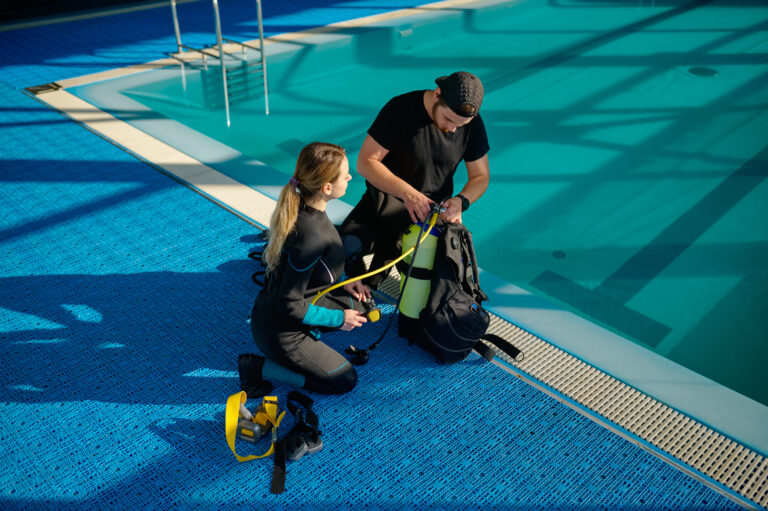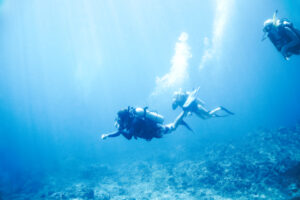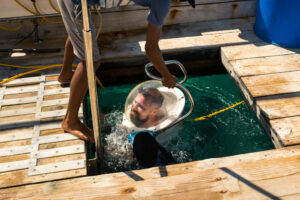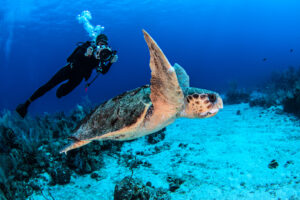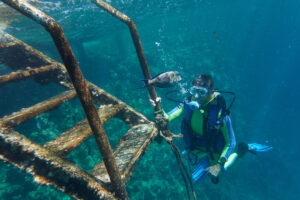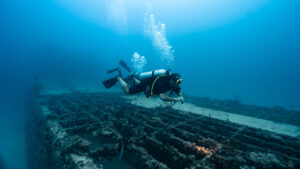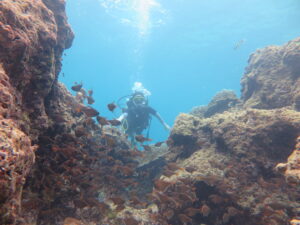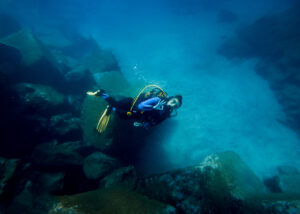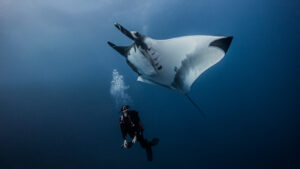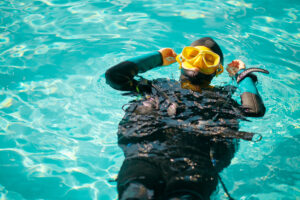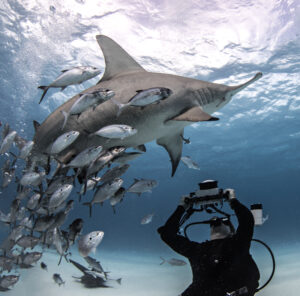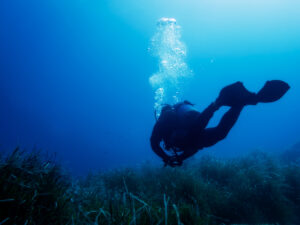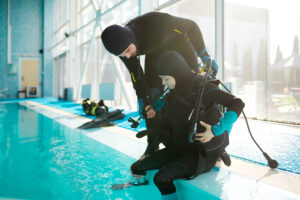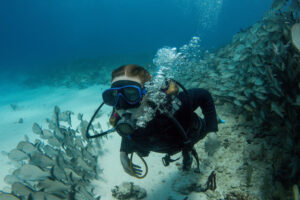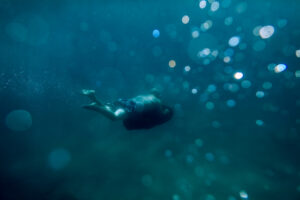What is SNUBA Diving?
Snuba diving is a unique and innovative underwater activity that blends elements of snorkeling and traditional scuba diving. Unlike traditional scuba diving, where divers carry their air supply on their backs, Snuba divers are connected to an air supply that floats on the surface through a long hose. This setup allows divers to experience the underwater world with greater ease and less equipment. Snuba diving is an accessible introduction to underwater exploration for those who may find the equipment and training requirements of scuba diving daunting. It offers a way to experience the ocean’s depths without the need for extensive training or heavy gear.
History and Development of Snuba Diving
Snuba diving was invented in the mid-1980s by Michael Stafford and later developed into a commercial venture by California diver and inventor, Jack N. Tucker. The idea stemmed from the desire to create an underwater experience that was more accessible than scuba diving but offered more freedom than snorkeling. The first Snuba system was patented in 1987, and it quickly gained popularity in tropical destinations where scuba diving was already a popular activity.
The development of Snuba diving was driven by the need to provide a safe, easy-to-use system that could introduce people to underwater activities without the rigorous training and certification required for scuba diving. Over the years, improvements in the design and technology of Snuba equipment have made it safer and more user-friendly. This evolution has included enhancements in the materials used for hoses and floats, better harness systems, and more reliable air delivery mechanisms.
As Snuba diving gained popularity, it spread to various tourist destinations around the world. Resorts and diving operators recognized the potential of Snuba as an introductory underwater experience for tourists. Today, Snuba diving is offered in numerous locations globally, from the Caribbean to the Great Barrier Reef, providing countless individuals with the opportunity to experience the underwater environment in a controlled and enjoyable manner.
Equipment and Gear
The equipment used in Snuba diving is specifically designed to simplify the underwater experience while ensuring safety. The most distinctive feature of Snuba diving is the long hose that connects the diver to an air supply floating on the surface. This hose allows divers to descend to depths of up to 6 meters (about 20 feet) without carrying heavy tanks on their backs. The air supply is typically housed in a raft or small boat that follows the diver’s movements, ensuring a continuous supply of air.
A Snuba harness is worn by the diver, securing the regulator and providing a comfortable and stable connection to the air hose. The harness system is designed to be easily adjustable, accommodating divers of different sizes. The regulator, which the diver breathes from, is similar to those used in scuba diving but is connected to the surface air supply rather than a tank carried by the diver. This design simplifies the breathing process, making it accessible even for those with no prior diving experience.
Another essential piece of equipment is the weight belt, which helps divers achieve neutral buoyancy underwater. The amount of weight used varies based on the diver’s body composition and the salinity of the water. Fins and a mask complete the basic Snuba diving gear, allowing for easy movement and clear vision underwater. The combination of these elements creates a streamlined and straightforward system that makes underwater exploration accessible and enjoyable for a wide range of individuals.
Training and Skills Required
Snuba diving requires significantly less training compared to traditional scuba diving. Typically, a brief orientation session lasting about 15 to 30 minutes is sufficient to prepare participants for their Snuba experience. During this session, divers are introduced to the basic principles of Snuba diving, including how to use the regulator, manage buoyancy, and communicate underwater using hand signals.
Unlike scuba diving, Snuba does not require participants to have certification. This lack of a certification requirement makes Snuba an attractive option for individuals who want to experience underwater activities without committing to a comprehensive training program. The skills needed for Snuba diving are minimal, focusing primarily on basic safety procedures and comfort in the water. This accessibility is one of the key factors contributing to the popularity of Snuba diving as a recreational activity.
Participants are usually accompanied by a certified Snuba guide who ensures their safety throughout the dive. The guide remains on the surface, monitoring the air supply and the divers’ movements. This supervision allows participants to feel secure and supported, making Snuba diving an excellent option for families and groups with varying levels of swimming proficiency. The presence of a guide also ensures that any potential issues can be quickly addressed, further enhancing the safety and enjoyment of the experience.
Environmental Impact and Conservation
Snuba diving, like all underwater activities, has the potential to impact the marine environment. However, when conducted responsibly, its impact can be minimized. Snuba operators are typically well-versed in best practices for reducing ecological disruption. These practices include educating divers on the importance of not touching or disturbing marine life, avoiding contact with coral reefs, and adhering to designated dive paths to prevent damage to the underwater habitat.
The controlled nature of Snuba diving makes it an excellent platform for promoting environmental awareness and conservation. Many Snuba tours incorporate educational components that inform participants about the marine ecosystem, the species they are likely to encounter, and the importance of preserving these natural environments. By fostering a sense of appreciation and respect for the underwater world, Snuba diving can inspire participants to support conservation efforts.
In addition to educating divers, many Snuba operators actively participate in conservation initiatives. These initiatives may include reef restoration projects, marine life monitoring programs, and beach clean-ups. By integrating conservation efforts into their operations, Snuba operators contribute to the preservation of marine environments and promote sustainable tourism practices. The emphasis on environmental stewardship helps ensure that future generations can continue to enjoy and benefit from the underwater experiences Snuba diving provides.
Popular Snuba Diving Destinations
Snuba diving is offered in a variety of locations worldwide, each providing unique underwater experiences. One of the most popular destinations for Snuba diving is the Caribbean, known for its crystal-clear waters and vibrant coral reefs. Locations such as Aruba, the Bahamas, and the Cayman Islands offer Snuba diving tours that allow participants to explore the rich marine biodiversity and colorful underwater landscapes of the region.
Hawaii is another top destination for Snuba diving. The islands’ diverse marine life, including sea turtles, tropical fish, and manta rays, make it an exciting location for underwater exploration. Snuba diving tours in Hawaii often take place in sheltered bays and coastal areas, providing calm and safe conditions for participants. The volcanic underwater topography adds an element of adventure and intrigue to the experience.
Australia’s Great Barrier Reef is also a renowned destination for Snuba diving. As the world’s largest coral reef system, it offers unparalleled opportunities to observe a wide array of marine species and stunning coral formations. Snuba diving tours on the Great Barrier Reef cater to both beginners and experienced divers, ensuring that everyone can appreciate the beauty of this natural wonder. The emphasis on sustainable tourism practices in this region also highlights the importance of preserving such a valuable ecosystem.
Health and Safety Considerations
While Snuba diving is generally considered safe, there are some health and safety considerations that participants should be aware of. One of the primary risks associated with Snuba diving is barotrauma, which occurs when pressure changes cause damage to body tissues. To mitigate this risk, divers are instructed on proper equalization techniques to balance pressure in the ears and sinuses as they descend and ascend.
Participants with certain medical conditions, such as respiratory or cardiovascular issues, should consult with a healthcare provider before engaging in Snuba diving. Pregnant individuals and those with recent injuries or surgeries may also need to avoid Snuba diving to prevent complications. Most Snuba operators require participants to complete a medical questionnaire to identify any potential health concerns before diving.
Safety protocols are a critical component of Snuba diving operations. These protocols include thorough equipment checks, clear communication systems, and the presence of trained guides who can assist in case of emergencies. Divers are also instructed on the use of hand signals for underwater communication and are provided with a detailed briefing on what to expect during the experience. By adhering to these safety measures, Snuba diving can be a safe and enjoyable activity for a wide range of participants.
Key Takeaways
Snuba diving is an accessible and enjoyable way to experience underwater exploration without the need for extensive training or heavy equipment. With a surface-supplied air system, minimal training requirements, and a focus on safety, Snuba diving provides a unique opportunity to connect with the marine environment. Whether in the Caribbean, Hawaii, or the Great Barrier Reef, Snuba diving offers an unforgettable experience that promotes environmental awareness and appreciation for the underwater world.

